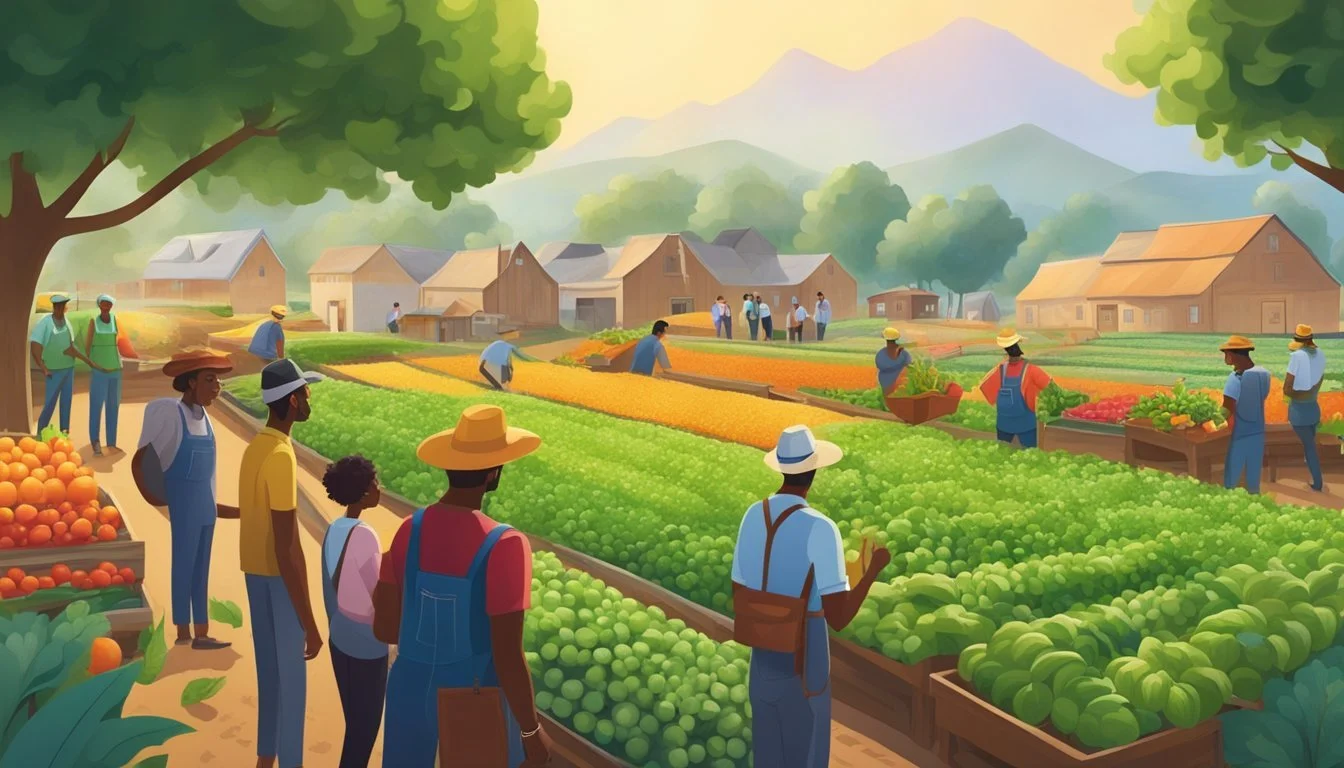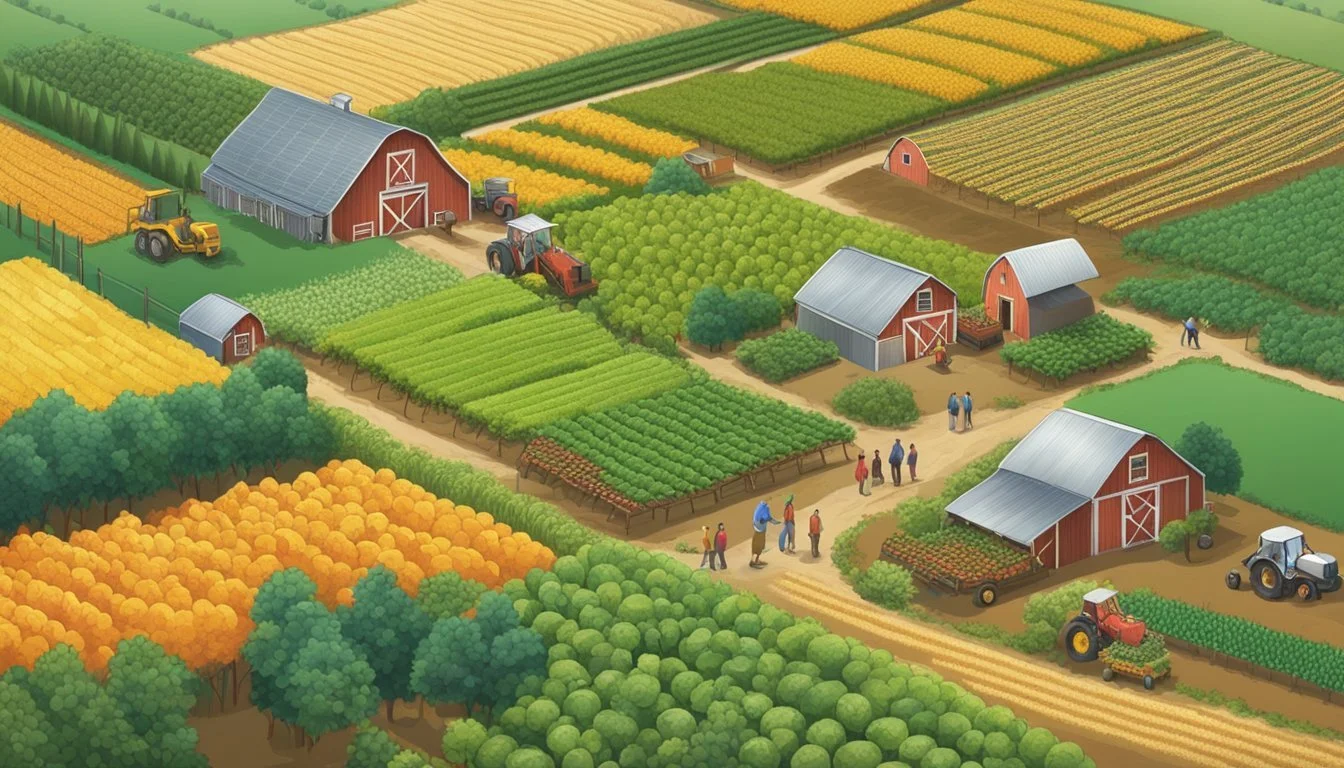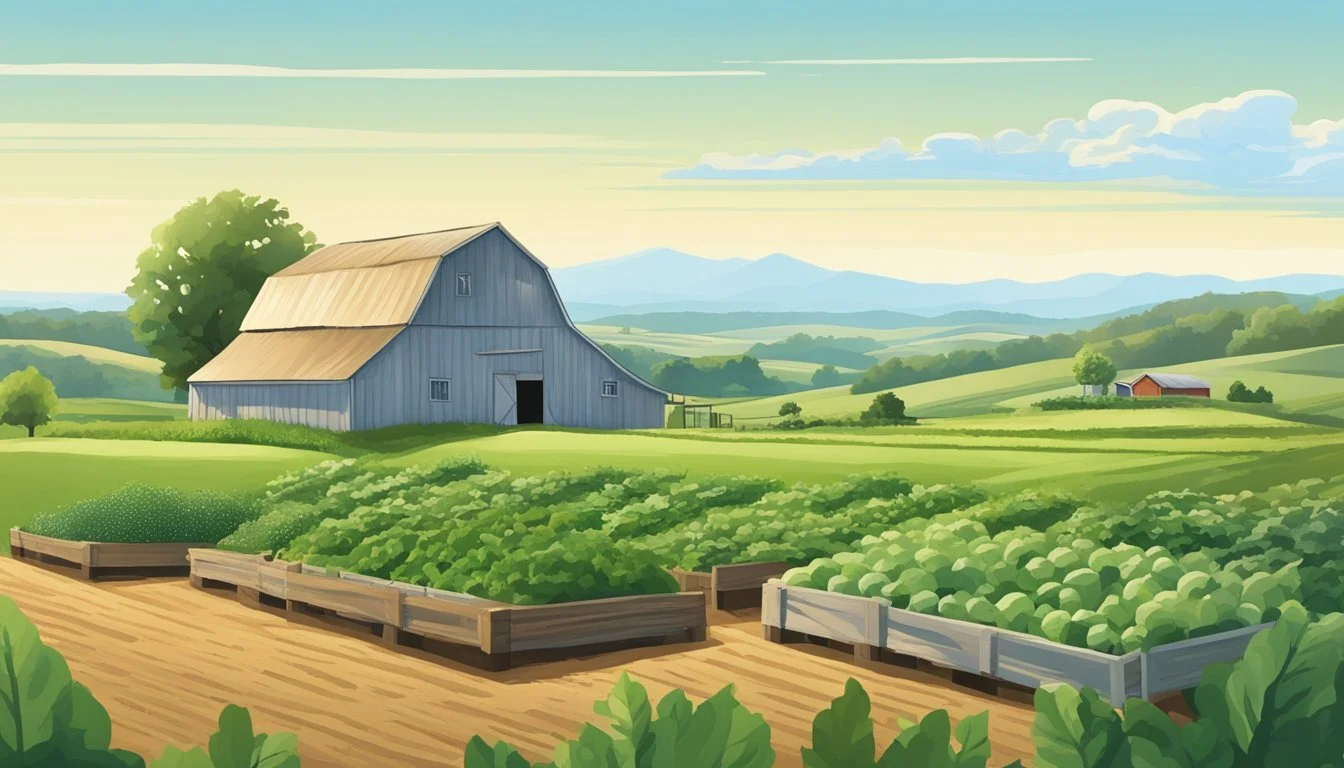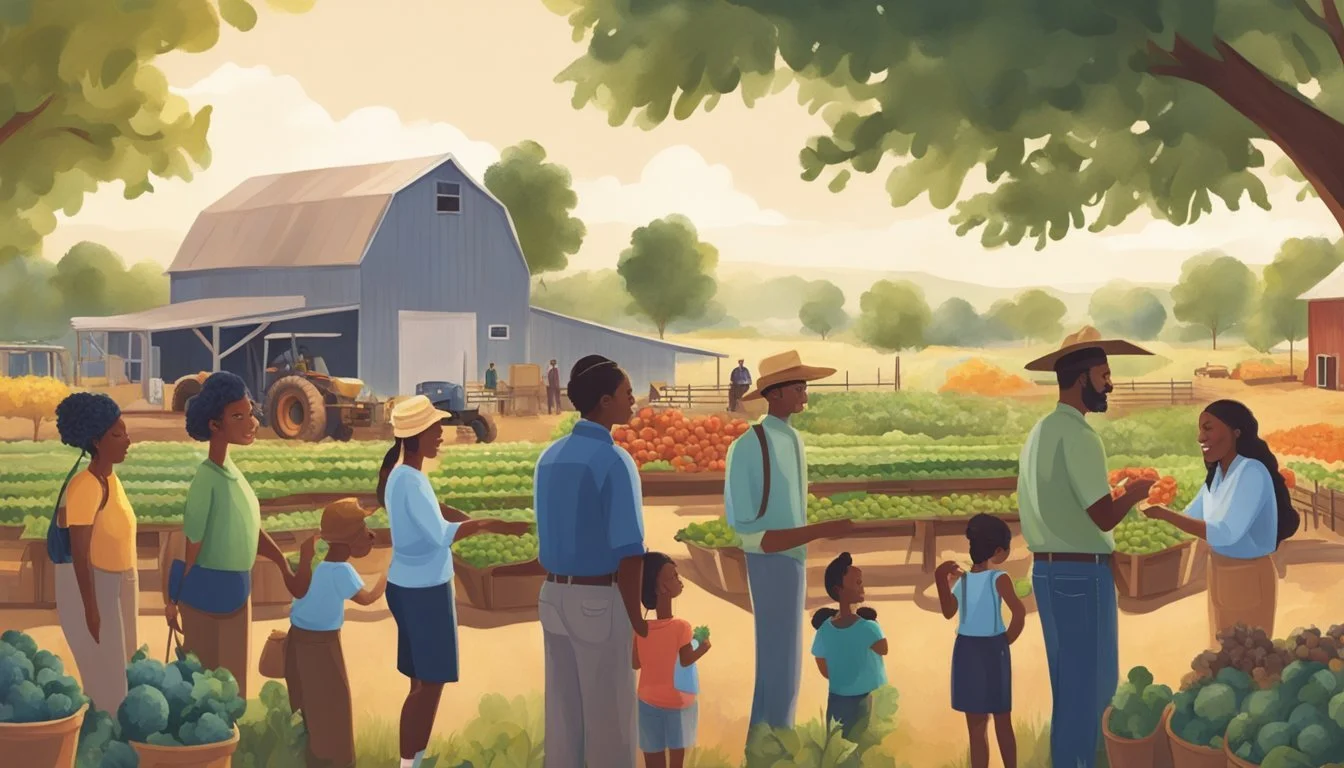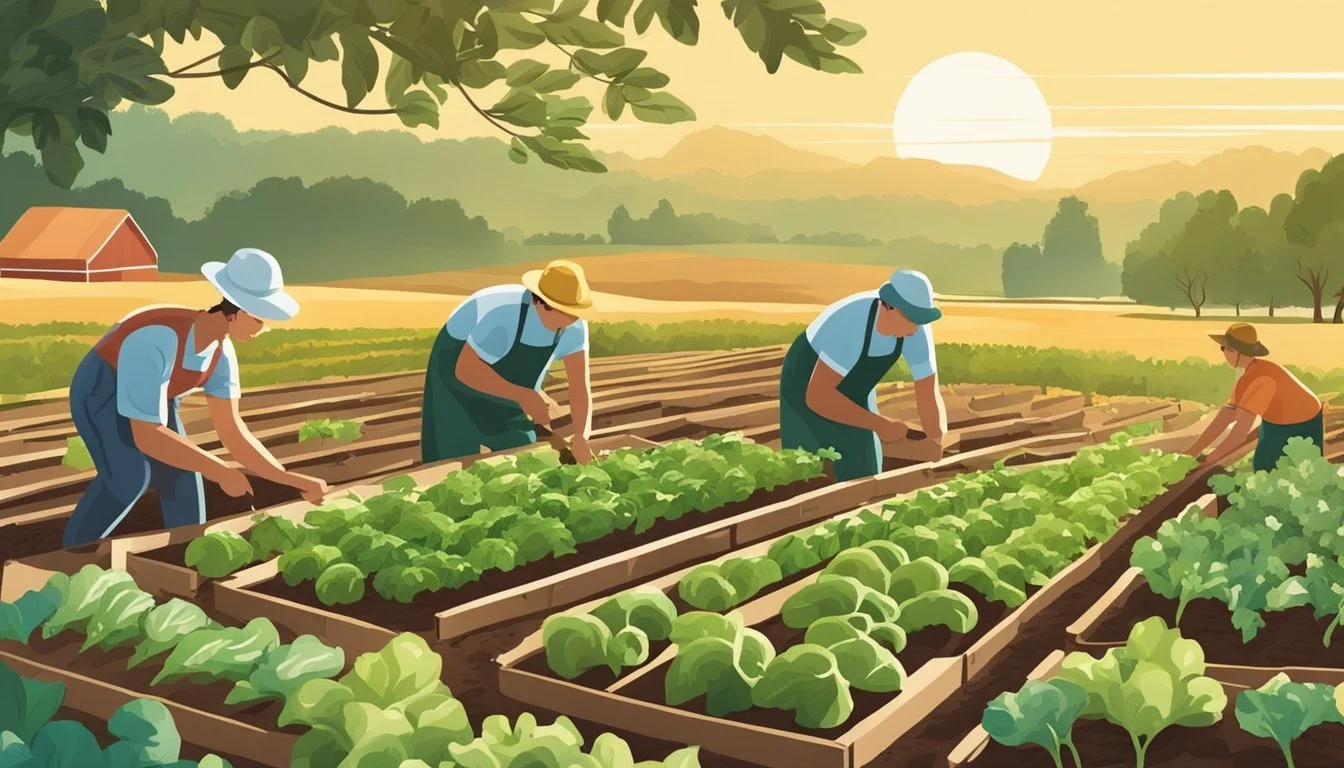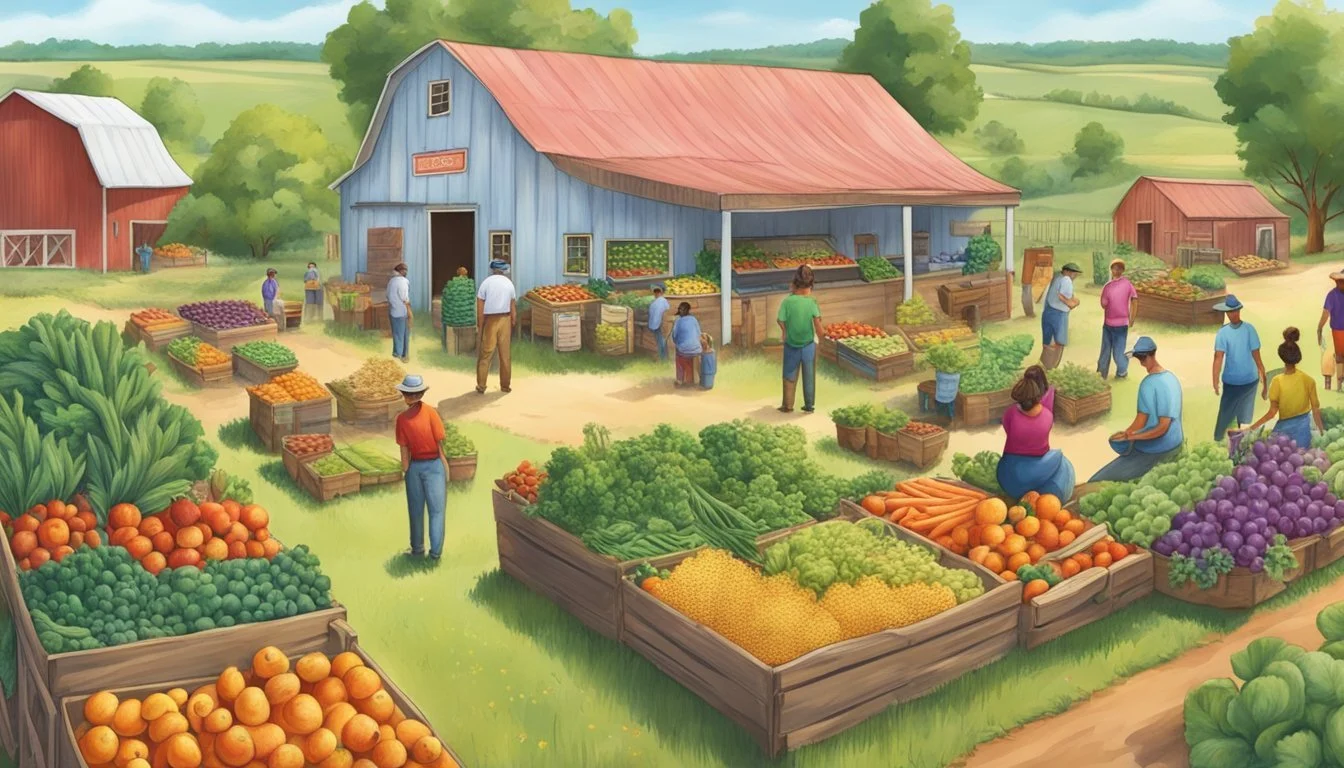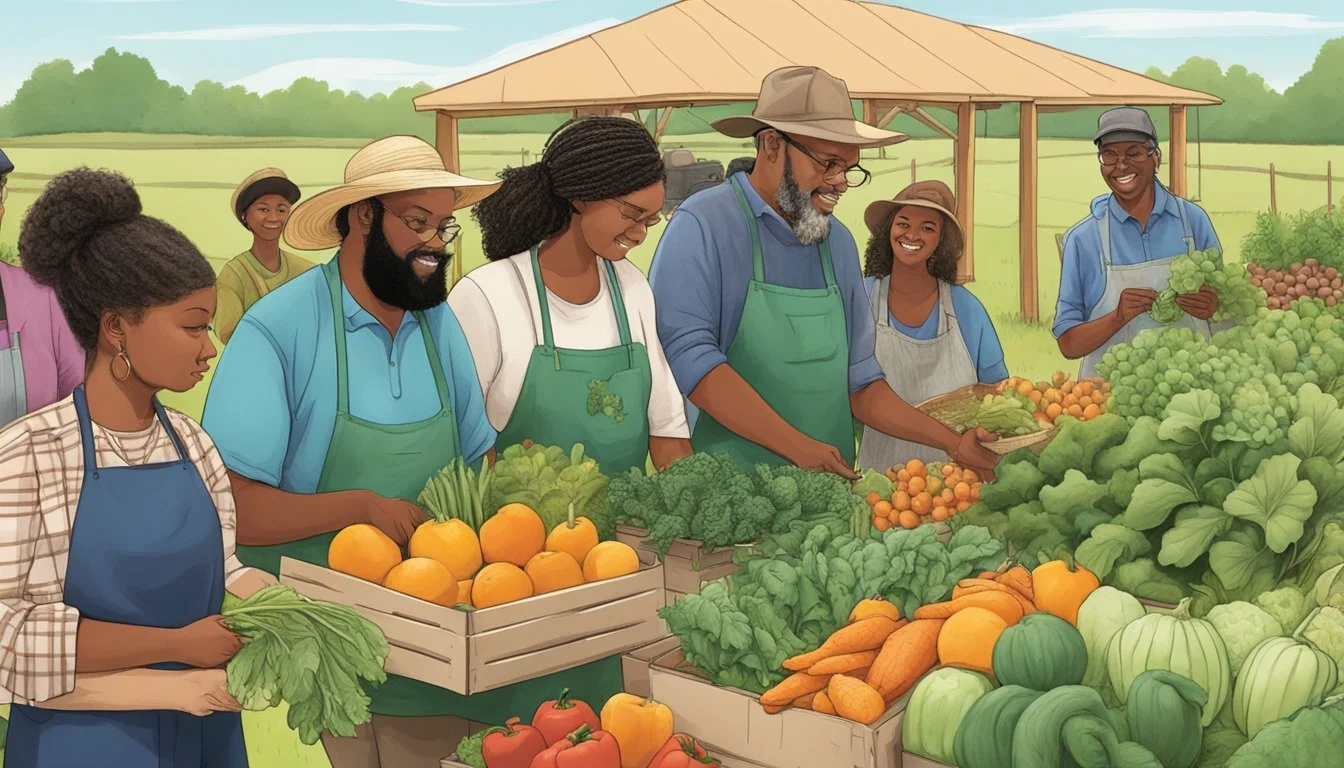Community Supported Agriculture (CSA) in Oklahoma
A Guide to Local Produce Subscription
Community Supported Agriculture, commonly referred to as CSA, is an approach to food production and distribution that directly connects producers and consumers within Oklahoma. In a CSA model, consumers purchase shares of a farm's anticipated harvest upfront, providing farmers with working capital at the start of the growing season. This system fosters a closer relationship between consumers and their food source, as members of a CSA receive regular distributions of farm-fresh produce, typically on a weekly basis, throughout the farming season.
CSAs in Oklahoma offer a variety of produce and sometimes include options for meat, dairy, and other farm products. By participating in a CSA, Oklahomans are able to enjoy fresh, local food while also contributing to the financial stability and success of their local farms. Each farm operates its own unique CSA program, with variations in the length of the subscription period, the amount and variety of produce provided, and the pricing.
This agricultural model does more than ensure a supply of fresh produce; it plays an important role in sustaining local agriculture and building community. CSA members have the advantage of knowing where their food comes from and often gain insights into the farming process. Oklahoma's growing number of CSA farms illustrates the rising interest in community-supported agriculture and reflects a statewide commitment to supporting local farmers and enjoying the benefits of locally sourced food.
The Fundamentals of Community Supported Agriculture (CSA)
Community Supported Agriculture represents a significant departure from traditional agriculture models, fostering close connections between local farmers and consumers.
Defining CSA and Its Core Concepts
Community Supported Agriculture (CSA) is a model where consumers purchase shares of a farm's anticipated harvest. This pre-purchase arrangement provides farmers with upfront capital, which stabilizes their revenue streams and reduces the financial risks associated with crop production. Shares typically consist of a weekly or bi-weekly delivery of vegetables, fruits, and sometimes additional farm products like eggs or dairy. CSA members pay at the beginning of the growing season, effectively becoming stakeholders in the farm's output.
History and Evolution of CSA in the U.S.
The CSA model originated in Japan in the 1960s and arrived in the United States in the 1980s. The first CSAs were established on the East Coast, responding to growing concerns about food safety, the environment, and supporting local economies. Farmers in the U.S. have increasingly adopted CSA to diversify their sales and secure a more reliable income while promoting sustainable and organic farming practices. Given its community-oriented nature, CSA has been integral in reducing the food miles by linking consumers more directly with the source of their food.
Community Supported Agriculture in Oklahoma
In Oklahoma, CSA has seen growth as consumers and farmers alike recognize the mutual benefits of this partnership. Local farmers offer Oklahomans fresh, seasonally available produce, strengthening the state's agricultural economy and providing consumers with healthier food options. CSA in Oklahoma also adheres to the broader principles of supporting sustainable agriculture and enhancing community engagement through direct farmer-to-consumer relationships.
CSA Operations and Structure
Community Supported Agriculture in Oklahoma reflects a partnership between local farms and community members who purchase shares of the farm's output. It embodies a model where consumers directly support farmers, ensuring they receive fresh, local produce while contributing to the sustainability of the farms they endorse.
How CSA Farms Operate
CSA farms in Oklahoma operate by allowing members to buy into the farm at the beginning of the growing season. This upfront capital helps farmers cover initial annual costs such as seeds and equipment. In return, members receive regular distributions of the farm’s harvest, which typically vary week-to-week based on what is in season. Distribution points are often set up at convenient locations within the community, like markets or designated drop-off points in Oklahoma City, Stillwater, or Tulsa.
Types of CSA Models
CSA models can vary. Some farms offer single-farm CSAs, where all produce is sourced from one farm. Others may operate on a co-op model, where multiple farms contribute to the shares, increasing the variety of available produce. Oklahoma's CSA landscape includes both types, giving consumers options based on their preferences for diversity or farm-specific support.
Membership and Share Structures
Members typically purchase a share at the beginning of the season, with options for different sizes based on family needs. A small share might feed an individual or a couple, while larger shares could be suitable for families. Some CSAs offer payment plans or sliding scales to make membership accessible to a broader range of the community. In Oklahoma, share structures might include:
Spring, Summer, and Fall Shares: with a varying number of participants.
Single Farm Share: produce exclusively from one farm.
Co-op Shares: produce from multiple local farms.
CSAs rely on a mutually beneficial structure where the risk and rewards of farming are shared, fostering a sense of connection and responsibility between the farmers and the community.
Benefits of CSA
Community Supported Agriculture (CSA) programs play a significant role in establishing a stable market for fresh produce while supporting local agriculture and communities. These programs offer a variety of advantages for both consumers and producers, underlining the importance of a sustainable food system.
Advantages for Consumers
Consumers benefit significantly from CSA programs. They gain access to fresh, seasonal produce, often picked at the peak of ripeness, which can lead to better nutritional content and enhanced flavor. CSA participation allows them to directly support their local farmers without the intermediaries often found in grocery store supply chains. As a result, consumers often enjoy cost savings in the long term, and attain firsthand knowledge of where and how their food is grown.
Health Benefits: Regular consumption of fresh fruits and vegetables is linked to improved health.
Education: They learn about the seasonality of food and sustainable farming practices.
Diversity of Produce: Exposure to a wider variety of fruits and vegetables is common, encouraging a more diverse diet.
Advantages for Farmers and Local Food Systems
Farmers who participate in CSA schemes receive financial stability from subscription-based revenue, helping them to plan and manage their crops more efficiently. It also facilitates a closer connection to consumers, allowing for immediate feedback and the ability to respond to specific community needs. Local food systems benefit as money stays within the local economy and helps to reduce the carbon footprint associated with long-distance food transportation.
Financial Security: Prepaid CSA shares provide farmers with necessary funds prior to the harvest season.
Reduced Waste: Farmers can plan their crops according to the number of shares sold, leading to less food waste.
Market Expansion: Farmers can use CSAs as a platform to expand into other markets such as farmers' markets and local food events.
Impact on Community and Sustainability
CSA programs foster a sense of community by connecting individuals through a shared support of local farms. They help in building resilient local food systems that are less dependent on global supply chains. Their emphasis on sustainability contributes to conservation efforts, such as protecting local wildlife and maintaining healthy soil, which are critical components in the fight to mitigate climate change.
Community Engagement: CSA programs create opportunities for community activities, including farm visits and volunteer work.
Sustainable Practices: They often encourage farming techniques that minimize harmful impacts on the environment.
Local Economy: Strengthening the local economy is a ripple effect of keeping consumer dollars within community boundaries.
Organic and Environmental Considerations
Community Supported Agriculture (CSA) in Oklahoma is deeply intertwined with organic practices and the well-being of the environment. Such initiatives prioritize the health of consumers, producers, and ecosystems, focusing on sustainable, locally-driven agriculture that emphasizes organic certification, resource conservation, and sustainable farming techniques.
CSA and Organic Certification
CSAs in Oklahoma often pursue organic certification to ensure their produce meets stringent standards. Certified organic farms must adhere to regulations set by the USDA, which includes avoiding synthetic fertilizers and pesticides, maintaining soil fertility, and utilizing crop rotations. Organic certification not only reinforces the integrity of farming practices but also builds consumer trust.
Local Farms and Sustainability Practices
Local farms involved in CSA programs are committed to sustainability practices. These farms prioritize soil health, biodiversity, and reduced carbon footprints. Sustainable practices may include using cover crops, natural pest management, and conservation tillage, which aligns with the ethos of CSA by fostering a local, environmentally sound, and sustainable food system.
Water Usage and Conservation
Effective water usage and conservation are critical components of sustainable farming, particularly in CSA models. In Oklahoma, CSA farms often implement innovative water management strategies including:
Drip irrigation to minimize wastage
Rainwater harvesting systems
Proper soil management to enhance water retention
Water conservation in farming contributes significantly to the health of local waterways and preserves vital resources for future agricultural endeavors.
CSA Programs in Oklahoma
Community Supported Agriculture, known as CSA, offers a direct way for consumers to invest in local farms and receive fresh, seasonal produce. In Oklahoma, these programs support a sustainable food system and encourage community involvement in agriculture.
Prominent CSA Farms in Oklahoma
Guilford Gardens in Oklahoma City is amongst the noteworthy CSA farms in the region. It operates on a two-acre farm producing naturally grown food and serves around 60-90 members across three seasons. Another key player is Sloth Acres, based in Bristow, offering a diverse range of pastured poultry, pork, and microgreens besides its vegetable shares. These farms exemplify a commitment to quality and the local food movement.
Three Springs Farm is one of the dedicated CSA farms in the state as well, but more information would be needed to describe its specific offerings or locality.
Guilford Gardens: Oklahoma City, OK
Sloth Acres: Bristow, OK
Joining a CSA: Considerations for Oklahomans
When Oklahomans decide to join a CSA, they commit to supporting their local farmers and the seasonal rhythm of food production. Potential members should consider the length of the CSA season, the share types offered, and pick-up locations. It's vital to confirm whether the farm employs chemical-free practices if that aligns with personal values. Communication with the farmers can provide insights into their farming methods and produce availability.
Seasonal Produce Selection in Oklahoma CSA
Oklahoma's varying climate allows for a diverse range of seasonal produce throughout the year. CSA members can expect a rotation of vegetables and fruits depending on the season. Summer months typically bring an abundance of tomatoes, peppers, and summer squash, while cooler seasons offer root vegetables and greens. It's essential for CSA members to adapt to the seasonal nature of their food and embrace the variety that comes with each share.
Summer: Tomatoes, Peppers, Summer Squash
Cooler Seasons: Root Vegetables, Greens
Economic and Social Impact
Community Supported Agriculture (CSA) programs in Oklahoma have bolstered food security and empowered local farmers, particularly in addressing the needs of low-income households.
CSA's Role in Food Security
In Oklahoma, CSAs have significantly contributed to food security by providing consistent access to fresh, locally grown produce. This direct-to-consumer model ensures that community members have reliable sources of nutritious food, diminishing reliance on long-distance food transportation that may be subject to disruptions.
Supporting Family and Small Farms
CSAs are pivotal in supporting family and small farms in Oklahoma. By providing a predictable income stream through subscription-based sales, local farmers can sustain their operations and invest in their farms' future without the complete uncertainty of traditional markets. This model also fosters closer connections with community members, who in turn gain a deeper understanding of the agricultural process.
CSAs and Low-Income Households
The CSA model in Oklahoma has made strides in including low-income households, which often face significant barriers to accessing fresh produce. Some CSAs adopt a sliding scale fee structure, accept food assistance programs, like SNAP, or provide subsidized shares to make healthy, local foods more affordable. These initiatives ensure broader access, aligning economic and social wellbeing with food equity.
Additional CSA Products and Offerings
While Community Supported Agriculture is often associated with the delivery of fresh, seasonal produce, many CSAs in Oklahoma are expanding their offerings well beyond fruits and vegetables. These expanded options provide consumers with a greater variety of local products throughout the year.
Beyond Produce: Dairy, Meat, and Other Products
Oklahoma CSAs offer a plethora of products besides vegetables, such as dairy, meat, and additional farm-produced goods. Specifically, milk and beef shares are available, providing members with regular distributions of fresh, local dairy and high-quality cuts of meat. Other products may include seasonal staples such as corn, squash, and eggplant, ensuring a well-rounded diet.
Specialty Items: Flowers, Herbs, and Heirlooms
Individual farms often feature a selection of specialty items that enhance the CSA experience. Members might find themselves delighted by weekly or bi-weekly shares of vibrant cut flowers and aromatic herbs, adding beauty and flavor to their homes. Those interested in biodiversity and taste may opt for shares including heirloom varieties of fruits and vegetables, celebrating the rich agricultural heritage of Oklahoma.
Setting Up a CSA Farm
Community Supported Agriculture (CSA) farms build direct relationships between farmers and consumers. By purchasing shares, consumers get a regular supply of farm products, while farmers gain a stable income and shared risk. In Oklahoma, initiating a CSA can be a transformative venture for sustainable agriculture.
Planning and Starting a CSA Farm
Preparation is fundamental in establishing a CSA farm. To start, farmers should evaluate their resources, such as land, equipment, and labor. Identifying the target market and planning logistics for share distribution are also crucial. Farmers must choose which farm products they will offer. This usually consists of a diverse array of seasonal produce, and may sometimes extend to include other farm goods.
The next step involves logistics and shareholder recruitment. Farmers must strategically plan planting schedules so that there's a consistent harvest for shares. Seeds should be selected based on the seasonal produce they wish to offer, alongside consideration of the region's climate and soil conditions.
Key Actions Description Resource Assessment Enumerate available resources such as land, equipment, and workforce. Market Research Define the target consumer base and establish demand for CSA shares. Product Selection Decide on the types and varieties of produce and goods to be offered. Planting Schedules Develop a timeline for planting and harvesting to ensure weekly supply. Shareholder Recruitment Market shares to the public, detailing produce offerings and policies.
Tools and Resources for Success
Efficient farming tools are essential for a productive CSA operation. Bootstrap Farm in Yale, OK exemplifies a successful CSA model, utilizing tools that accommodate their production of heirloom, organic, and Non-GMO produce. The use of high-quality, reliable tools can aid farmers in maintaining a diverse and consistent range of products.
Resources such as community workshops, agricultural extensions, and CSA networks can provide farmers with additional support. These resources offer insights on best farming practices, business strategies, and networking opportunities. With the right tools and resources, farmers can enhance the sustainability and profitability of their CSA farm.
Essential Tools Resources for Farmers Tillage equipment Agricultural extension programs Irrigation systems CSA networking groups Harvesting implements Workshops and training sessions for sustainable farming Seed starting kits Online forums for CSA farmers
By focusing on robust planning, product selection, and the acquisition of the right tools and support, a CSA farm can serve as a cornerstone for fresh, local food supply within the Oklahoma community.
Case Studies and Success Stories
Community Supported Agriculture in Oklahoma showcases the symbiotic relationship between consumers and producers. This section explores specific instances where local CSAs have flourished, offering insights into their operations and the impact they have on the community.
Three Springs Farm: A Model of CSA Success
Three Springs Farm, nestled in Oaks, Oklahoma, epitomizes CSA triumph. Founded by Emily Oakley and Mike Appel, their approach centers around providing a full-season CSA share to members. These shares include a diverse array of vegetables, herbage, and flowers, all cultivated with rigorous organic methods that underscore their commitment to sustainability. The bond between local farmers and the community is at the heart of their model, with Oakley and Appel sharing not just their produce, but also their farming experience, fostering a well-informed community that values the source of their food.
Innovative CSA Practices in Oklahoma
Innovation in CSA practices throughout Oklahoma has been pivotal in adapting to changing markets and customer preferences. Many CSAs have begun integrating flexibility into their share options, such as customizable share boxes, to cater to individual needs. This level of customization has not only increased participation but has strengthened the CSA model's resilience, ensuring that it remains a viable and beneficial system for both local farmers and consumers. Through dynamic methods and a relentless pursuit of improvement, Oklahoma's CSAs continue to thrive and serve as a testament to sustainable agricultural success.
Challenges and Adaptations
In Oklahoma, Community Supported Agriculture (CSA) programs face a variety of challenges, but with targeted adaptations, they can continue to play a vital role in sustainable food production.
Overcoming the Challenges Faced by CSAs
CSAs in Oklahoma contend with several challenges, from climatic stressors to market competition. Drought and erratic weather patterns, influenced by climate change, pose significant threats to crop yields and farm stability. The U.S. Department of Agriculture (USDA) provides guidance on resilient farming practices to mitigate these effects. Additionally, CSAs must navigate economic hurdles such as balancing cost and accessibility to maintain a strong member base, ensuring financial sustainability.
Local CSAs have adopted various strategies to combat these challenges:
Diversifying crops to reduce the risk of complete loss from a single weather event
Implementing water-conservation practices to combat drought
Offering flexible membership options to attract a broader range of community members
Collaborative marketing efforts with other local food producers to strengthen their market presence
Adapting CSA Models to Changing Conditions
The adaptation of CSA models in response to changing conditions is crucial for their continued success. The transition towards organic farming methods is not only environmentally sustainable but also meets the increasing consumer demand for organic produce. By adhering to the regulations set forth by the USDA, CSAs ensure quality and build trust among their members.
To meet the evolving needs of their members and stay relevant in the competitive market, CSAs are adopting the following adaptations:
Integrating technology to facilitate easier subscription management and communication
Expanding distribution channels including home deliveries or creating strategic drop-off points to increase convenience
Engaging in educational outreach to inform the community about the benefits of CSA membership and sustainable agriculture practices
By embracing these adaptations, CSAs in Oklahoma can continuously provide local, sustainably grown food and foster community resilience against agricultural challenges.
Outlook for CSA in Oklahoma
Community Supported Agriculture (CSA) in Oklahoma is poised for meaningful growth, supported by a rising interest in local food and sustainable farming practices. This section will explore key trends and the expansion of CSA into Oklahoma's urban areas.
Future Trends in Local Agriculture
Local food movement: The demand for fresh, locally-sourced produce in Oklahoma is growing. This trend supports the expansion of CSA programs as consumers seek to connect with local farmers. CSAs in the state are responding by offering a wider variety of produce and incorporating options for year-round subscriptions.
Efficiency and technology: Advancements in agricultural practices are likely to bolster CSA productivity in the state. Embracing technologies for better crop management and distribution logistics can help Oklahoma CSAs meet the increasing consumer demand.
Expanding Urban Agriculture and CSA
Urban growth: Oklahoma's urban centers such as Oklahoma City and Tulsa are experiencing a surge in urban agriculture initiatives. This growth provides a fertile ground for CSA programs to thrive and serve the community with fresh local food, directly from city-based farms or nearby rural areas.
Community engagement: As urban agriculture expands, CSA programs in locations like Edmond are engaging communities through education and participation opportunities. This involvement not only supports the local economy but also fosters a closer consumer-farmer relationship, which is at the heart of CSA principles.
Consumer Education and Involvement
Consumers interested in CSA need to understand the value of shares and how to engage with local CSA communities to maximize their benefits from fresh produce.
Understanding the Value of CSA Shares
A CSA share represents a portion of a local farm's harvest. Typically, consumers pay in advance for a season’s worth of fresh fruits and vegetables. This upfront payment allows farmers to plan and fund their operations. Consumers benefit by receiving a periodic selection—usually weekly—of freshly harvested produce. The sizes of shares vary, and they may feed an individual, a couple, or a family, often determined by the farm's offerings and the consumers' vegetable consumption.
Types of CSA Shares:
Full Share: Suitable for families or individuals with high vegetable consumption.
Half Share: Ideal for individuals or smaller households.
Payment for CSA shares helps sustain local farms in Oklahoma and ensures that the consumers receive a steady supply of fresh produce throughout the farming season. Participation in a CSA also typically offers consumers education about their food sources, seasonal produce, and preparation methods.
Engaging with Local CSA Communities
Community involvement in CSAs is crucial. It fosters a direct connection between consumers and their food sources. Consumers can engage by:
Visiting the farms: Provides a deeper understanding of farming practices.
Volunteering: Farmers often appreciate extra help during peak times.
Community events: Farms may host seasonal events encouraging CSA member participation.
This involvement strengthens the bond between consumers and local farms, fostering a sense of community and enhancing the consumers' education about where their food comes from. Additionally, it creates opportunities for consumers to learn more about fresh fruits and vegetable consumption within their local ecosystem.


